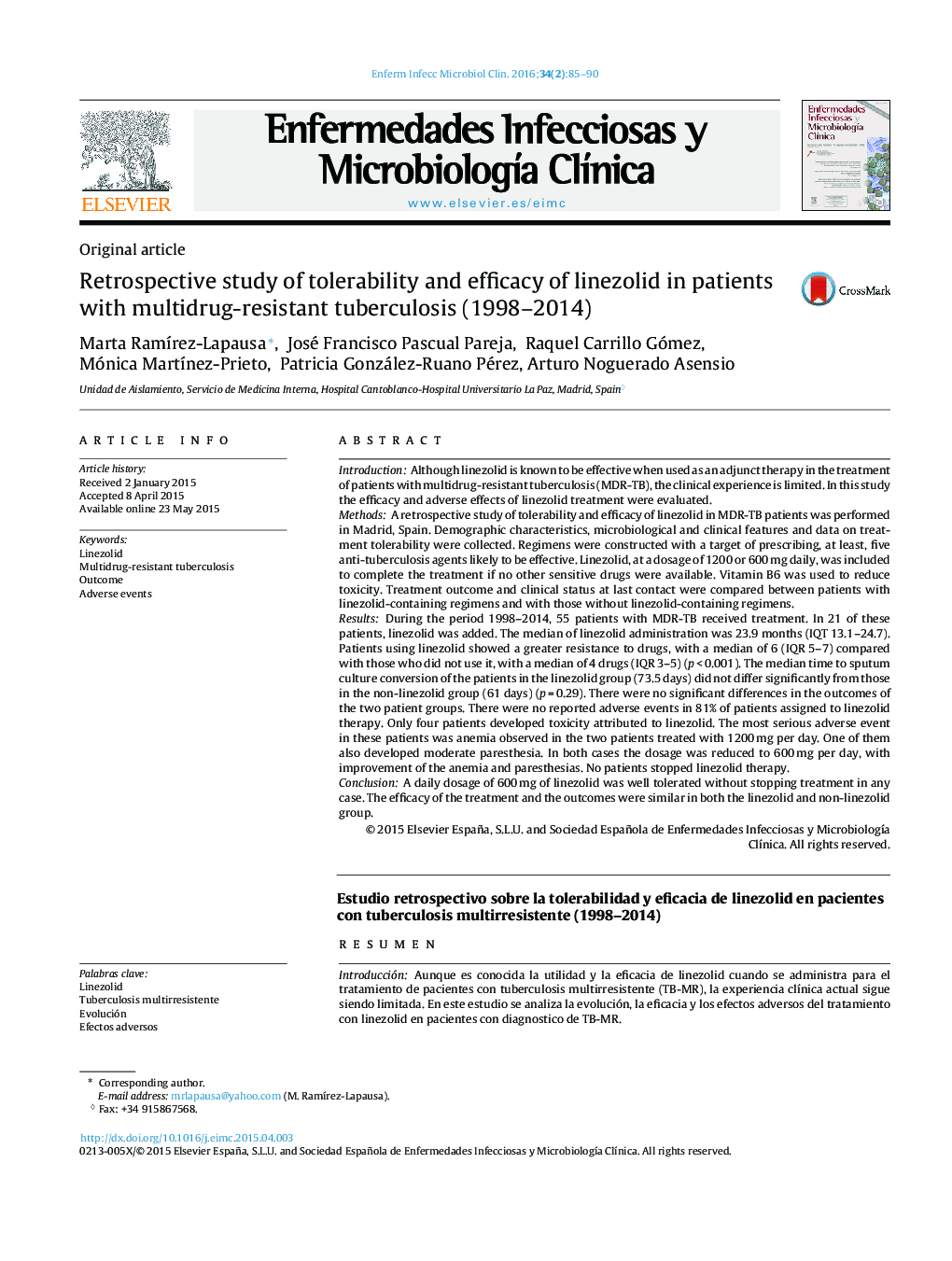| کد مقاله | کد نشریه | سال انتشار | مقاله انگلیسی | نسخه تمام متن |
|---|---|---|---|---|
| 3400604 | 1222620 | 2016 | 6 صفحه PDF | دانلود رایگان |

IntroductionAlthough linezolid is known to be effective when used as an adjunct therapy in the treatment of patients with multidrug-resistant tuberculosis (MDR-TB), the clinical experience is limited. In this study the efficacy and adverse effects of linezolid treatment were evaluated.MethodsA retrospective study of tolerability and efficacy of linezolid in MDR-TB patients was performed in Madrid, Spain. Demographic characteristics, microbiological and clinical features and data on treatment tolerability were collected. Regimens were constructed with a target of prescribing, at least, five anti-tuberculosis agents likely to be effective. Linezolid, at a dosage of 1200 or 600 mg daily, was included to complete the treatment if no other sensitive drugs were available. Vitamin B6 was used to reduce toxicity. Treatment outcome and clinical status at last contact were compared between patients with linezolid-containing regimens and with those without linezolid-containing regimens.ResultsDuring the period 1998–2014, 55 patients with MDR-TB received treatment. In 21 of these patients, linezolid was added. The median of linezolid administration was 23.9 months (IQT 13.1–24.7). Patients using linezolid showed a greater resistance to drugs, with a median of 6 (IQR 5–7) compared with those who did not use it, with a median of 4 drugs (IQR 3–5) (p < 0.001). The median time to sputum culture conversion of the patients in the linezolid group (73.5 days) did not differ significantly from those in the non-linezolid group (61 days) (p = 0.29). There were no significant differences in the outcomes of the two patient groups. There were no reported adverse events in 81% of patients assigned to linezolid therapy. Only four patients developed toxicity attributed to linezolid. The most serious adverse event in these patients was anemia observed in the two patients treated with 1200 mg per day. One of them also developed moderate paresthesia. In both cases the dosage was reduced to 600 mg per day, with improvement of the anemia and paresthesias. No patients stopped linezolid therapy.ConclusionA daily dosage of 600 mg of linezolid was well tolerated without stopping treatment in any case. The efficacy of the treatment and the outcomes were similar in both the linezolid and non-linezolid group.
ResumenIntroducciónAunque es conocida la utilidad y la eficacia de linezolid cuando se administra para el tratamiento de pacientes con tuberculosis multirresistente (TB-MR), la experiencia clínica actual sigue siendo limitada. En este estudio se analiza la evolución, la eficacia y los efectos adversos del tratamiento con linezolid en pacientes con diagnostico de TB-MR.MétodoSe realizó un estudio retrospectivo sobre la tolerabilidad y la eficacia de linezolid en pacientes diagnosticados de TB-MR en Madrid, España. Los regimenes de tratamiento se constituyeron con al menos 5 fármacos antituberculosos efectivos. Linezolid (a dosis de 1200 o 600 mg por día) se añadió para completar el tratamiento en los pacientes en los que no existían otros fármacos alternativos sensibles. Se utilizó vitamina B6 para reducir la toxicidad al tratamiento. Se comparó la evolución clínica de los pacientes y los resultados del tratamiento entre el grupo de pacientes tratados con linezolid y el grupo de pacientes que no fueron tratados con este fármaco.ResultadosEntre 1998 y 2014, 55 pacientes fueron diagnosticados de TB-MR y recibieron tratamiento. En 21 pacientes fue necesaria la administración de linezolid. La media de tiempo de administración de linezolid fue de 23.9 meses (IQR 13.1-24.7). Los pacientes del grupo de linezolid presentaron mayor número de resistencias a fármacos con una mediana de 6 (IQR 5-7), respecto al grupo que no tomó Linezolid [4 fármacos (IQR 3-5)] (p < 0,001). No hubo diferencias significativas entre el tiempo de conversión del cultivo de esputo de los pacientes del grupo de linezolid (73,5 días) frente al del grupo sin linezolid (61 días) (p = 0,29). Tampoco hubo diferencias significativas en la evolución de los dos grupos de pacientes. El 81% de los pacientes que tomaron linezolid no experimentaron efectos adversos atribuidos a la administración de Linezolid. Sólo cuatro pacientes desarrollaron toxicidad secundaria al uso de linezolid. El efecto adverso más importante fue anemia que se presentó en los dos pacientes tratados con 1200 mg al día. Uno de ellos también desarrolló parestesias de grado moderado en miembros inferiores. En ambos casos, la dosis se redujo a 600 mg al día, con mejoría de la anemia y de las parestesias.ConclusiónLa dosis de 600 mg al día de linezolid fue bien tolerada sin necesidad de interrumpir el tratamiento en ningún caso. La eficacia del tratamiento y la evolución de los pacientes fueron similares en ambos grupos.
Journal: Enfermedades Infecciosas y Microbiología Clínica - Volume 34, Issue 2, February 2016, Pages 85–90